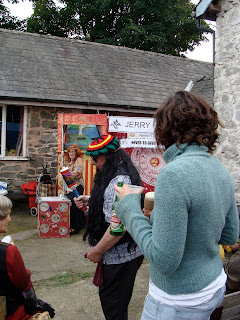We attended the recent 7 Sights meeting at Yorkshire Sculpture Park after being invited by Steve and Kate to participate in the 7 Sights project as artists. As we enjoyed the day, but unfortunately everyone involved couldn’t make it, we have decided to put our scepticism about the use and effectiveness of blogs (is anyone reading this?) to one side and post some information.
As Emma Rushton and Derek Tyman, we have been working collaboratively as artists since around 1997 (a date we both sometimes refute). Alongside working as practicing artists we both teach part-time, respectively in the Fine Art Departments at the University of Leeds and University College Falmouth. As artists we have tried to stay productive and keep the work progressing, hopefully avoiding easy categorisation and also interesting for us, so we have produced publications, gallery based installations, context specific projects and sometimes events and a number of videos. Most of these projects, objects and activities in different ways reveal our interest in sites, places, particular historical figures and events, politics, ideas of community and belonging and how people have and continue to resist the homogenisation of their lives. We have also realised a number of projects where we have invited artists and others to intervene or produced work in response to our own work.
Employed in Fine Art Departments we are both sceptical about the way artists knowledge, approaches to practice and ways of thinking and doing are becoming systematised, streamlined and undermined by the demands of the academy/institution as it moves ever closer towards a business model.
We work collaboratively to realise projects we probably couldn’t otherwise produce and to test and challenge our own orthodoxies. Within the practice we both have distinct interests and particular strengths and weaknesses. Attending the 7 Sights meeting seemed a more interesting use of time than a similar amount spent visiting Frieze Art Fair. We are interested to see how 7 Sights develops and what we might contribute and also extract? We envisage it might produce some work that is interesting and involve some unpredictable exchanges.
For our recent exhibition ‘The Wild’ (2009) a copy of Henry David Thoreau’s ‘cabin in the woods’ was constructed in the grounds of a former Natural History Museum and we are currently developing a new multi-site project ‘The Good Life’ for Lanternhouse in Ulverston, Cumbria, where we will be Artist-in-Residence in 2011. Perhaps there is a way to link some of this to 7 Sights?

















 cking his lips, all the babies died of starvation, but they still looked fat which was weired, maybe they had swelled up in the heat. It felt sad to see all that effort go to waste. I think I may be making some sort of point about feeding this idea and us all chipping in with the odd worm to keep things going.
cking his lips, all the babies died of starvation, but they still looked fat which was weired, maybe they had swelled up in the heat. It felt sad to see all that effort go to waste. I think I may be making some sort of point about feeding this idea and us all chipping in with the odd worm to keep things going.

